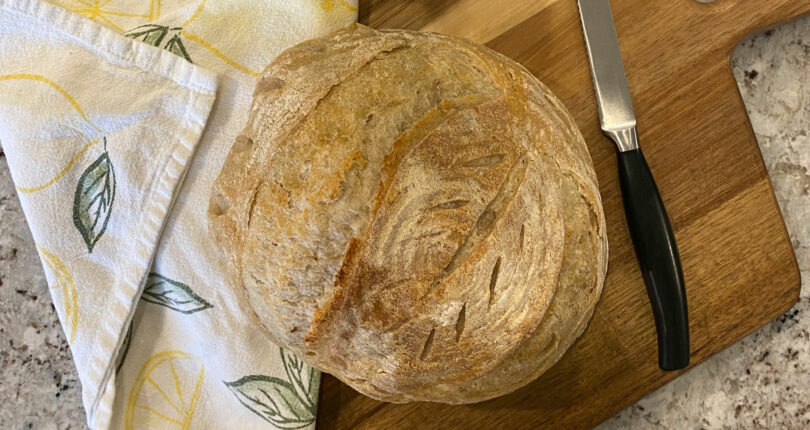Sourdough Bread
(Makes one boule or batard)
- 450g white bread flour
- 292g water (65%)
- 90g starter (20%)
- 9g salt (2%)
Times are approximate. It’s best to observe the dough’s behavior to determine its readiness for the next step.
- The night before baking, feed your starter in a clean jar at a ratio of 1:2:2 (e.g., 30g starter, 60g flour, 60g water). Cover with the lid and leave it at room temperature until it doubles. You want to have enough starter the next morning to make your loaf and have some left over to maintain your starter for the next loaf. You can also do a ratio of 1:4:4. The more flour and water you use, the longer it will take to double.
- In the morning, hand mix the flour and water in a bowl. Cover and leave for up to 2 hours (autolysis).
- Add salt and the starter and hand mix thoroughly in the bowl by stretching and folding the sides of the dough onto the top of itself for 10-15 minutes. Cover with a tea towel and let rest for 15 minutes.
- Dump the dough onto an unfloured surface and strengthen it by folding the sides onto itself and shaping it into a ball. I recommend watching dough strengthening videos on the Bread Code YouTube channel. Cover and let it rest for 15 minutes and oil a casserole dish.
- Fold each side of the dough on top of itself so it makes a small, layered rectangle. Place the dough in the oiled casserole, cover, and set aside. And so begins the bulk fermentation at room temperature. If your kitchen is cool, < 70 degrees, this may take all day. If the temperature is > 74 degrees, it could take 6-8 hours.
- During bulk fermentation, perform a set of gentle stretch and folds (aka coil folds) every 30-45 minutes for three or four times and then let the dough rest and rise. Observe the dough. If you have a cool kitchen, you want the dough to nearly double. In a warmer kitchen, it should increase about 75% in volume.
- Prepare a banneton or bowl by dusting it with rice flour. If using a bowl, line it with a dusted tea towel. Let the dough fall out onto a lightly floured counter. Preshape the dough by folding each side underneath and then gently tucking the dough around the bottom as you turn it. Let it rest for 15 minutes.
- Shape the dough into your final boule by stretching it into a small square. Fold two sides on top of it to create a rectangle, and then starting from a short end, roll it into a tight ball. Use a scraper to gently tuck the dough around the bottom as you turn it.
- Lift the boule and place it, tucked side up, in the dusted banneton or bowl. Pinch closed any openings on top of the boule and dust with rice flour. Let it rest for 30 minutes, cover, then put the boule in the fridge to cold proof overnight or 12-16 hours.
- The next morning, preheat a Dutch oven with the lid on in an oven at 435 degrees for at least an hour. Cut a square piece of parchment that you’ll use to lift the boule into the Dutch oven.
- Remove the boule from the refrigerator and flip onto the prepared parchment. Score a design into the bread using a clean, sharp razor blade at a 45-degree angle. Remove the Dutch oven from the oven and remove the lid. Use the parchment to lift the boule into the Dutch oven. Spritz the boule with water. Replace the lid. Bake for 20 minutes, then remove the lid and bake for 20 minutes longer or until the inside of the bread has reached 205 degrees.
- Allow to cool completely before cutting with a serrated knife. (I know this is the hardest part, but cutting the bread too early deflates the crumb.)

